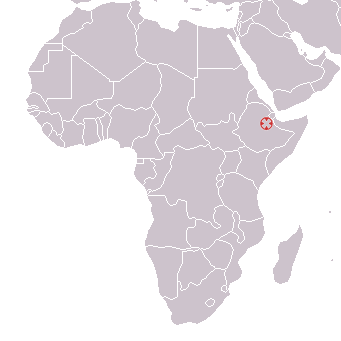Homo sapiens idaltu
| Homo sapiens idaltu Temporal range: Pleistocene (Lower Paleolithic), 0.16 Ma | |
|---|---|
| | |
| Scientific classification | |
| Kingdom: | Animalia |
| Phylum: | Chordata |
| Clade: | Synapsida |
| Class: | Mammalia |
| Order: | Primates |
| Suborder: | Haplorhini |
| Family: | Hominidae |
| Genus: | Homo |
| Species: | H. sapiens |
| Subspecies: | †H. s. idaltu |
| Trinomial name | |
| Homo sapiens idaltu White et al., 2003 | |
Homo sapiens idaltu, also called Herto Man,[1] is the name given to a number of around 160,000-year-old hominid fossils found in 1997 in Herto Bouri, Ethiopia. As "certain cranial traits are outside the range of modern human variation", paleoanthropologists determined that the finds belong to an extinct subspecies of Homo sapiens who lived in Pleistocene Africa.[1][2] According to scientists,[1] "[the fossil findings] predate classic Neanderthals and lack their derived features ... are morphologically and chronologically intermediate between archaic African fossils and later anatomically modern Late Pleistocene humans ... represent the probable immediate ancestors of anatomically modern humans ... their anatomy and antiquity constitute strong evidence of modern-human emergence in Africa."[1][3]
"Idaltu" is derived from a Saho-Afar word and translates to "elder" or "first born".[1][4]
Discovery
The fossilized remains of H. s. idaltu were discovered at Herto Bouri near the Middle Awash site of Ethiopia's Afar Triangle in 1997 by Tim White, but were first unveiled in 2003.[1] Herto Bouri is a region of Ethiopia under volcanic layers. According to radioisotope dating, the layers are between 154,000 and 160,000 years old. Three well preserved crania are accounted for, the best preserved being from an adult male (BOU-VP-16/1) having a brain capacity of 1,450 cm3 (88 cu in). The other crania include another partial adult male and a six-year-old child.[1][5]
Morphology and taxonomy
These fossils differ from those of chronologically later forms of early H. sapiens, such as Cro-Magnon found in Europe and other parts of the world, in that their morphology has features, that show resemblances to more primitive African fossils, such as huge and robust skulls, yet a globular shape of the brain-case and the facial features typical of H. sapiens.[6][1]
Anthropologist Chris Stringer argued in a 2003 article in the journal Nature that "the skulls may not be distinctive enough to warrant a new subspecies name".[7][8]
Despite the archaic features, these specimens were argued to represent the direct ancestors of modern Homo sapiens sapiens which, according to the "recent African origin (RAO)" or "out of Africa" model, developed shortly after this period (Khoisan mitochondrial divergence dated not later than 110,000 BCE) in Eastern Africa. "The many morphological features shared by the Herto crania and AMHS, to the exclusion of penecontemporaneous Neanderthals, provide additional fossil data excluding Neanderthals from a significant contribution to the ancestry of modern humans."[1]
A 2005 potassium-argon dating of volcanic tuff associated with the Omo remains showed them to date from about 195,000 years ago, making them older than the idaltu fossils and the earliest known remains of anatomically modern humans.[9]

See also
- Archaic humans
- Timeline of human evolution
- Life timeline
- List of fossil sites
- List of human evolution fossils
- Nature timeline
References
- 1 2 3 4 5 6 7 8 9 White, Tim D.; Asfaw, B.; DeGusta, D.; Gilbert, H.; Richards, G. D.; Suwa, G.; Howell, F. C. (2003), "Pleistocene Homo sapiens from Middle Awash, Ethiopia", Nature, 423 (6491): 742–747, Bibcode:2003Natur.423..742W, doi:10.1038/nature01669, PMID 12802332
- ↑ "Meet the Contenders for Earliest Modern Human". Smithsonian. January 11, 2012. Retrieved June 8, 2016.
- ↑ Amos, Jonathan (June 11, 2003). "Oldest human skulls found". BBC News. Retrieved June 8, 2016.
- ↑ "160,000-year-old fossilized skulls uncovered in Ethiopia are oldest anatomically modern humans". UC Berkeley. June 11, 2003. Retrieved June 7, 2016.
- ↑ "Pleistocene Homo sapiens from Middle Awash, Ethiopia". Macmillan Publishers Limited. Retrieved June 7, 2016.
- ↑ "HOMO SAPIENS IDALTU". Bradshaw foundation. Retrieved June 7, 2016.
- ↑ "Human evolution: Out of Ethiopia". Macmillan Publishers Limited. June 12, 2003. Retrieved June 7, 2016.
- ↑ "Herto skulls (Homo sapiens idaltu)". talkorigins org. Retrieved June 7, 2016.
- ↑ McDougall, I.; Brown, F. H.; Fleagle, J. G. (2005), "Stratigraphic placement and age of modern humans from Kibish, Ethiopia", Nature, 433 (7027): 733–736, Bibcode:2005Natur.433..733M, doi:10.1038/nature03258, PMID 15716951
External links
| Wikimedia Commons has media related to Homo sapiens idaltu fossils. |
-
 Data related to Homo sapiens idaltu at Wikispecies
Data related to Homo sapiens idaltu at Wikispecies - Origins - Exploring the Fossil Record - Homo sapiens idaltu Bradshaw Foundation
- 160,000-year-old fossilized skulls uncovered in Ethiopia are oldest anatomically modern humans, Robert Sanders, UC Berkeley, 11 June 2003.
- Missing link in human evolution found in Africa (abc.net.au 12 June 2003)
- Oldest Homo Sapiens Fossils Found, Experts Say (National Geographic News)
- Chris Stringer (Natural History Museum) Human origins; new fossil human finds in Ethiopia. 12 June 2003
- BBC report and image of the reconstructed skull discovered at Herto
- Homo sapiens idaltu - Nature Journal Article
- Fossil Hominids - Middle Awash Research Project
- Human Timeline (Interactive) – Smithsonian, National Museum of Natural History (August 2016).